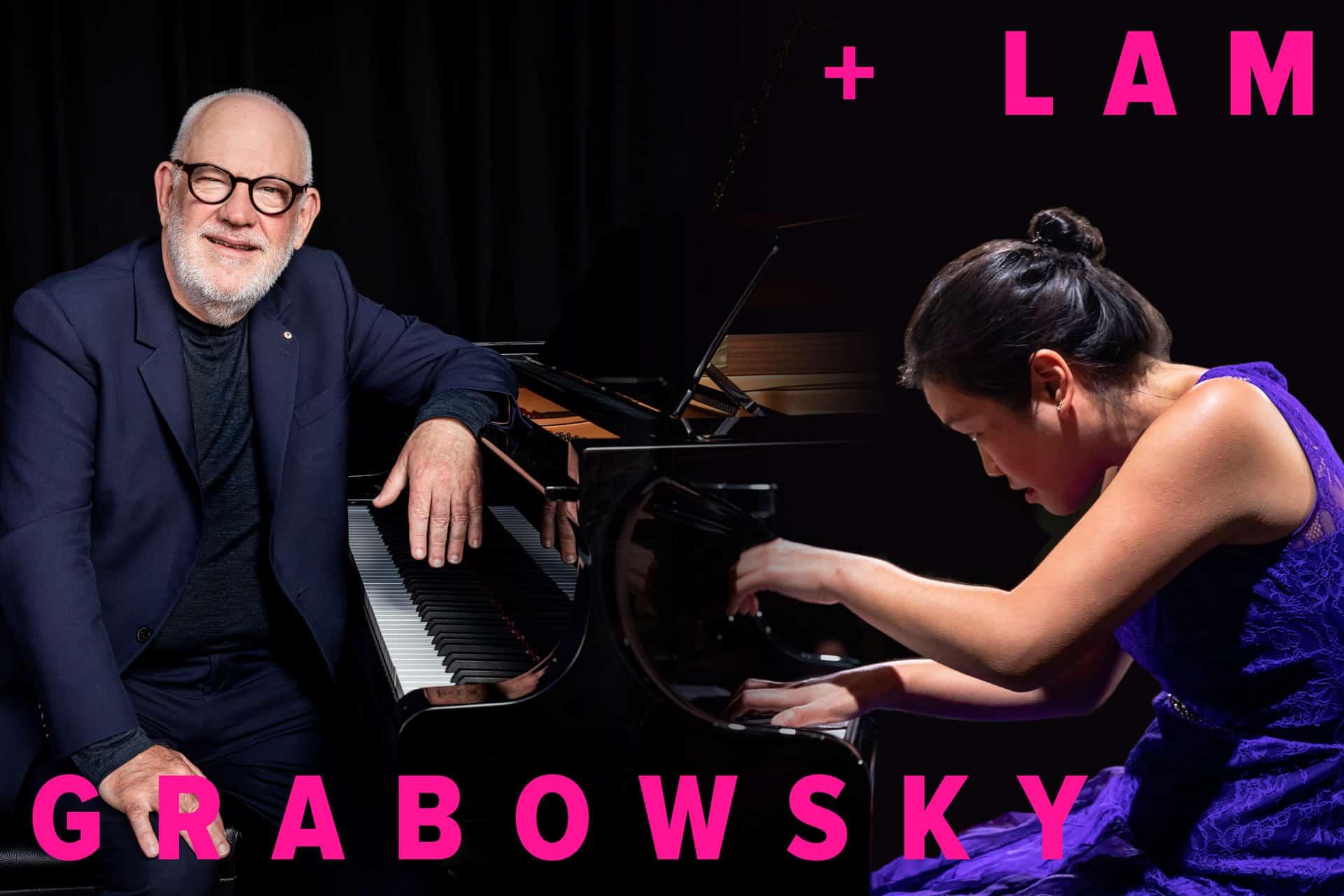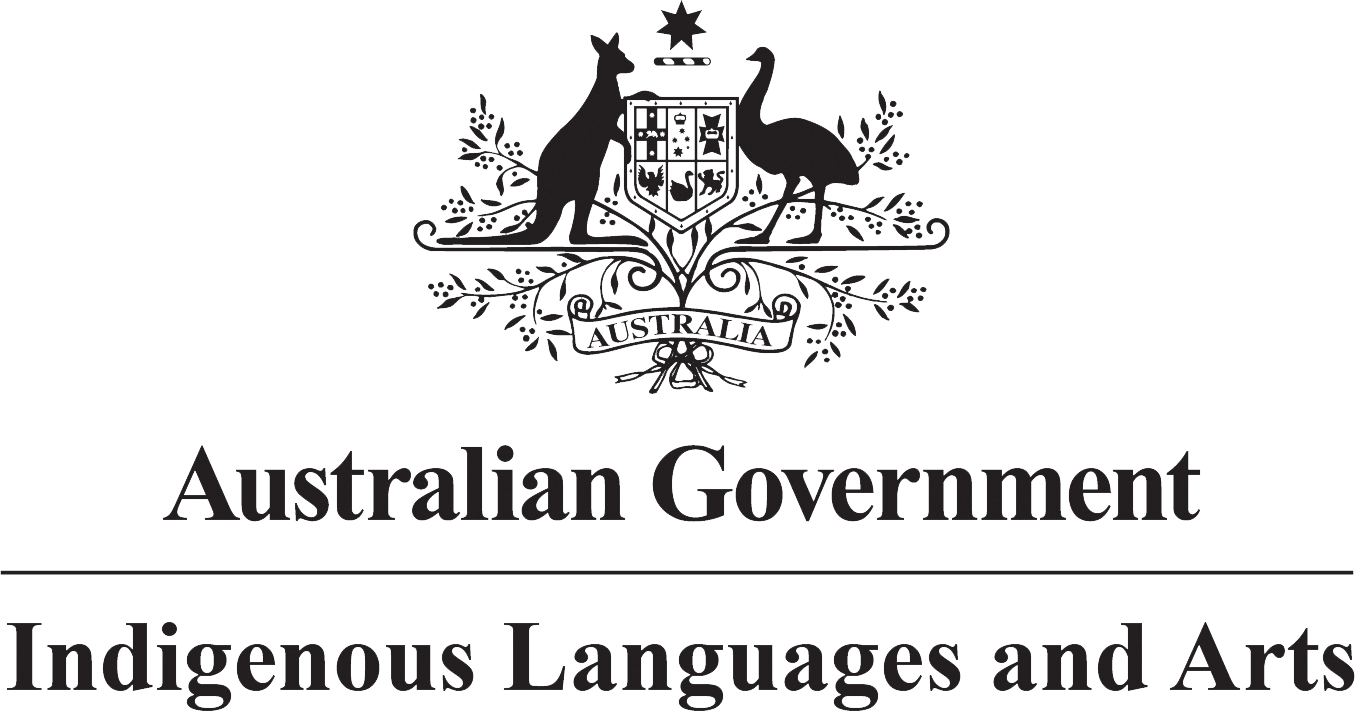In 1741 J. S. Bach sketched a simple, almost transparent, aria that he then spun into thirty miraculous variations. In this concert Andrea Lam and Paul Grabowsky present their very different takes on the resultant work, the Goldberg Variations.
DATE
Sunday 26 June 2022
4.30pm
Doors open @ 4.00pm
LOCATION
Four Winds Windsong Pavilion
Barragga Bay NSW 2546
PRICE
General Admission $55
Concession $49
16 years and under FREE
Access Pass holders – limited tickets available

Program
Johann Sebastian BACH (1685–1750)
Goldberg Variations, BWV 988 (1741)
Paul GRABOWSKY (b. 1958)
Improvisations on the Aria from Bach’s Goldberg Variations
The concert runs for 120mins including interval, and will commence with Artists in Conversation. Bar will be open for drink purchases at the start of the event and during interval.
Bookings are essential. Read more here about our venue’s Covid-19 protocols, and what to expect when you visit.
More information
Pianist Andrea Lam – who first performed with an orchestra at the age of thirteen, studied music at Yale, and whose praises have been sung by the Wall Street Journal – will play each note on the instrument where she earned her fame.
Legendary Australian musician Paul Grabowsky then has his turn, creating his own extraordinary, jazz-inflected response to Bach’s eternally beautiful theme.
Grabowsky can seem to create a pastiche of an idiom out of which a deep truth will grow in the improvising.
[Lam’s] melting lyricism, filigree touch and spirited eloquence were compelling. She played with a firm purpose, attention to nuance and produced a spectrum of ravishing colour.
Meet the Artists
Your Title Goes Here
Your content goes here. Edit or remove this text inline or in the module Content settings. You can also style every aspect of this content in the module Design settings and even apply custom CSS to this text in the module Advanced settings.
Andrea Lam
Pronounced a ‘real talent’ by the Wall Street Journal, and based in New York City for two decades, pianist Andrea Lam performs with leading orchestras and conductors in Australasia, Japan, China and the United States. From New York’s Carnegie Hall and Lincoln Center to the Sydney Opera House, she has played for Sydney Festival, the Huntington Estate Music Festival, Canada’s Orford Festival and the Chelsea Music Festival in the USA, with works from Bach, Schumann and Chopin to Aaron Jay Kernis, Liliya Ugay, and Nigel Westlake.
A keen chamber music collaborator, Andrea has performed with cellist Matt Haimovitz, pianist Melinda Lee Masur, the Australian String Quartet, and violinist Emily Sun (including on their 2021 ARIA-nominated album Nocturnes). Andrea also performs and records extensively as pianist of New York’s acclaimed Claremont Trio, including their most recent release Queen of Hearts (2022). An album of new solo piano works by Matthew Hindson is due for release later this year.
Andrea’s 2022 season includes soloist engagements with the Sydney, Adelaide and Tasmanian Symphony Orchestras, concerts at UKARIA Cultural Centre and Melbourne Recital Centre, and the Sydney Opera House’s Piano Day 2022 streamed event.
Andrea Lam was a semi-finalist in the 2009 Van Cliburn Competition, Silver Medallist in the 2009 San Antonio Piano Competition, and winner of the ABC’s Young Performer of the Year Award (Keyboard division) and the Yale Woolsey Hall Competition. She holds degrees from both the Yale and the Manhattan Schools of Music.
Professor Paul Grabowsky AO
Born in Lae, Papua New Guinea in 1958, Paul Grabowsky was raised in Melbourne where he attended Wesley College. During the late 70s he became prominent in the music scene in Melbourne, working in various jazz, theatre and cabaret projects.
He lived and worked in Europe and the US from 1980 to 1985, during which time he performed with many jazz luminaries including Chet Baker, Art Farmer and Johnny Griffin. He returned to Australia in 1986 and established a reputation as one of Australia’s leading jazz musicians with such bands as the Wizards of Oz and his own trio and sextet, and as musical director for singer Vince Jones.
He was musical director of the nationally televised variety show Tonight Live with Steve Vizard from 1990 to 1992. He was Commissioning Editor (Arts and Entertainment) for ABC Television from 1995 to 1998.
Paul has written the scores for over 20 feature films in Australia, the UK and US including Innocence (directed by Paul Cox), Last Orders, The Eye of the Storm and Words and Pictures (Fred Schepisi) and Shiner (John Irvin). His television credits include the series Phoenix, Janus and the Emmy-winning Empire Falls. His works for the theatre include four operas and various multimedia works. His most recent opera, created for soprano Emma Matthews, The Space Between, with libretto by Steve Vizard, premiered at Arts Centre Melbourne in 2018.
He is the Founding Artistic Director of the Australian Art Orchestra, which he led from 1994 to 2013.
Paul has won eight ARIA Awards (most recently in 2020 for his recording Please Leave Your Light On with singer Paul Kelly), two Helpmann Awards, several APRA and Bell Awards and a Deadly Award. He was the Sydney Myer Performing Artist of the Year in 2000, and received the Melbourne Prize for Music in 2007. He was the 2010 Australian National University H.C. Coombs Fellow.
He was Artistic Director of the Queensland Music Festival from 2005 to 2007 and of the Adelaide Festival of Arts for 2010 and 2012.
A professor at Monash University since 2012, Paul is currently director of the Monash University Performing Arts Centres and the Monash Art Ensemble. He oversaw the development of the Ian Potter Centre for Performing Arts, which opened in May 2019, and launched MLIVE, a year-round series of curated performances.
In 2014 he was made an Officer of the Order of Australia for services to music and arts administration.
About the Music
Your Title Goes Here
Your content goes here. Edit or remove this text inline or in the module Content settings. You can also style every aspect of this content in the module Design settings and even apply custom CSS to this text in the module Advanced settings.
Bach Goldberg Variations
J S Bach published four volumes of music collectively known as the Clavier-Übung, a how-to guide to playing the keyboard. In 1741, he published the final volume, ‘consisting of an Aria [melody] with diverse variations for the harpsichord’, now known as the Goldberg Variations. As in the other three volumes of the series, he added that the work was ‘prepared for the delight of the souls of lovers of music.’
Bach’s first biographer, JN Forkel, suggested that this work was commissioned by Count Hermann Carl von Keyserlingk, Russian ambassador to the Saxon court, to be played for him during his frequent bouts of insomnia by his young harpsichordist, Johann Gottlieb Goldberg. The story was undoubtedly fabricated — there is no dedication to Keyserlingk, and the virtuoso variations, except perhaps for their length, are an unlikely cure for insomnia! Forkel’s story, however, published in 1802, was popular enough to give the work its common name.
Goldberg himself was but a boy of 14 when the Variations were published. As a child prodigy who went on to a successful career as a virtuoso harpsichordist, the attribution is not inappropriate. The Variations are among the most technically demanding works ever written for the harpsichord. Bach uses the full resources of the instrument, and includes a number of variations requiring complex hand-crossings, unique in his output. It is possible that he was influenced by Domenico Scarlatti’s Essercizi, a set of 30 sonatas published in 1739 with similar technical demands.
Bach was writing for a double-manual harpsichord (i.e. a harpsichord with two keyboards), and specified which variations are to be played across the two keyboards. In some instances, this is done to facilitate the hand-crossings. In others it is to give the variation a certain colour. Modern pianists have the advantage of a greater range of volume and tone colour, and play all the written notes on their single keyboard.
Virtuosity and technique aside, what is most remarkable about these variations is their individual ingenuity and their combined unity. The mastery Bach demands of the player pales in comparison with the skill he demonstrates as a composer. The entire set of variations is based on a 32-bar bass-line and its implicit harmonies. There is no theme as such. The aria which precedes the variations — and which is repeated unaltered at the end — is simply one sarabande written over this bass-line. The melody of the sarabande is entirely forgotten during the variations, a fact which makes its return at the end all the more remarkable. In the essay accompanying his early performances and famous recording of the Goldbergs, Canadian pianist Glenn Gould wrote of the aria, ‘it is a singularly self-sufficient little air which seems to shun the patriarchal demeanour, to exhibit a bland unconcern about its issue, to remain totally uninquisitive as to its raison d’être.’
The ‘Aria’ of the Goldberg Variations is a sarabande, a common Baroque dance style. In Bach’s solo works for harpsichord, violin, and cello, it is the most expressive movement of a suite, often contemplative and tender.
What follows the opening Aria is a unique and breathtaking array of diverse movements composed over a common fundamental pattern. Much has been written about the overall organisation of the work and Bach’s fascination with numbers. The work has strong binary patterns: the 32 movements are built on a 32-note bass-line; each of them is in binary form (i.e. two halves, in this case of equal length, which may be repeated, though they are not in this program); and all phrases throughout are of two, four, or eight bars length. The entire work is divided in half, the first half starting with the Aria and ending with an unusual fade-away at the end of Variation 15, the second half starting afresh with a bold French overture, and ending with the restatement of the Aria.
At the same time, the 30 variations (bookended by the Aria movements) are strongly divided in groups of three, the last of each group a canon — starting with a canon at the unison, and climbing stepwise to a canon at the ninth. These are strict canons: one voice begins, the second voice entering a few beats later with precisely the same music. In the canon at the unison, the second voice enters at the same pitch, as we do in simple folk rounds. In subsequent canons, the second voice enters a tone higher, then a third higher, and so on. Bach sets all of these canons, except that at the ninth, in three parts, with the two imitative voices played over an independent bass-line.
Every third variation is in the form of a canon, the name given to a compositional technique in which two or more people play or sing the same music but start at different times, as in the children’s song ‘Row, row, row your boat.’ Bach excelled at this technique, writing canons that are so intricate that the listener may be unaware of the imitation.
Preceding the canon in each group of three variations is an arabesque-like movement — a virtuoso display of ‘hands at play’, often crossed and on two manuals — and a genre piece, that is, a dance, a little fugue, etc. In place of the tenth canon Bach substitutes a boisterous quodlibet, a German tradition of simultaneously singing various popular tunes. In this case Bach offers several tunes, among them Kraut und Ruben haben mich vertrieben (Cabbage and beetroot have driven me away) and another, Ich bin so lang nicht bei dir gewest (I’ve been so long away from you), arranging them in a solid four-part setting over what is the clearest statement of the fundamental bass-line in the entire work.
The Aria returns immediately after, a gesture both simple and remarkably touching. Not a note of it is altered from the first time we heard it, but its effect on the listener is utterly different. Simply stated, it has changed from a greeting to a farewell.
With the Goldberg Variations, Bach completed his thorough and systematic exploration of writing for the keyboard that began with the Two- and Three-Part Inventions and Well-Tempered Clavier, and ended with the four volumes of the Clavier-Übung. He also began his great musical testament of ‘speculative’ works in which a single theme is taken on a complex musical journey, works that include the Musical Offering, Canonic Variations, and the Art of the Fugue. In the Goldberg Variations we have a piece that in many ways is the perfect balance between art and science. Theorists can spend years analysing the work and its implications. Keyboard players can spend a lifetime exploring its endless facets. Music lovers can listen to it ‘for their souls’ delight’.
Adapted from a note by Charlotte Nediger ©2016
Andrea Lam's Musings
Listening to the Goldberg Variations for the first time is like meeting someone who gives you goosebumps. You can’t explain why it has such an effect on you, but it moves you to your core. Mine was as a music student many years ago, feeling alone and cold in my dorm room during a brutal New York winter, I casually popped in a CD of Glenn Gould’s 1981 recording of the Goldberg Variations. I did not move for 51 minutes.
When Paul Kildea floated the brilliant idea of pairing Bach’s Goldberg Variations with improvisations on the Aria by Paul Grabowsky, my mind lit up and the idea made complete sense. The piece feels like a giant jazz riff, built on an eight-note bass idea which Bach’s endless imagination takes through all sorts of musical styles, humour, poetry, intimate melancholy. Each variation takes a single idea and goes to town with it.
The Goldberg Variations have become the stuff of legends and myths over the centuries – countless brilliant minds have dissected the mathematical intricacies to an atomic level and countless souls have been affected by it, especially in times of need – Brahms immersed himself in the Goldberg Variations in the wake of his mother’s death.
Maybe it’s the close coexisting relationship of the transcendent and the tangible. The sublime beauty and the constant work. Bach’s deep faith and the responsibilities of a church job. The buoyant freedom and the strict following of canonic rules. In my practice, the sudden tears at its beauty and the tossing my hands up at the logistical puzzles and the tricky acrobatics. Bach’s sense of humour and the relationship of the elevated and everyday appear most explicitly in the last variation Quodlibet (akin to a modern day mash-up).
During these strange times, many of us turned to Bach’s music for solace. I think in times of chaos and uncertainty, there is comfort in the perfect architecture of Bach’s music combined with the sublime beauty. Maybe there is no need to know why this piece moves us so deeply. But simply to feel that it does.
Paul Grabowsky's Musings
In 2007, due to the sudden unavailability of a Finnish jazz pianist, I was asked by Paul Kildea at short notice to perform an improvised response to the Goldberg Variations as part of a concert at the Festival of Perth. I had little time to think about it, so simply allowed the situation to carry me. Improvisation demands of the player the ability to draw on many things, including memory, technique, fantasy and an instinctive sense of some kind of architectural proposition that takes the audience ‘on the journey’. J S Bach’s great work demonstrates yet again his total mastery of the contrapuntal arts, combining unrivalled rigour with unbridled fun. I can only imagine he must have chuckled at the ingenuity of the many canonical tricks he presents while retaining a rhetorical lightness of touch.
My approach to this challenge has been honed by the opportunity to reflect on how I can pay tribute to the composer who has had the greatest influence on my musical life, by drawing on my own adventures in music. Of course, the jazz tradition represents the nervous system of what I will do, but that alone suggests many different responses. The two presiding spirits rising out of, and above, that tradition are Miles Davis and Ornette Coleman, the former as an alchemist who understood jazz to be a process of continual renewal, the latter as a philosopher for whom everything in music is relational. This is a powerful and reassuring idea for improvisors in that it defines agency, and an open conceptual framework within which to be bold. In preparing, I have spent hours looking at the harmonic structure of the Aria, playing it in all keys (major and minor) and combining various keys simultaneously. I’ve played with various tempi and grooves, and with greater and lesser degrees of adherence to form. I have set nothing in stone. Every performance will be different, a surprise not just to the audience, but to me.
An interview with the artists by Harriet Cunningham
It’s not a conventional collaboration. They won’t be rehearsing together. In fact, they don’t need to meet until the night of the first performance. But when they do meet, composer and jazz pianist Paul Grabowsky and classical pianist Andrea Lam will be sharing a common obsession: Bach’s Goldberg Variations.
What does Bach mean to them?
‘I grew up playing Bach,’ says Paul Grabowsky. ‘I trained as a classical pianist from the age of five and my teacher was a great lover of Bach. He used to call Bach ‘the Master’. That made a huge impression on me, and Bach has remained one of those things that I just keep going back to. It’s music of such depth and wisdom and it’s also just beautiful to play. I love its linearity.’
Bach’s music has proved so fascinating to jazz musicians, Paul says, partly because Bach is the model, the consummate improvisor. But there are other factors at play, including the composer’s command of polyphony and counterpoint, combined with the technological developments in instrument design which opened up new harmonic worlds for Bach and his contemporaries.
‘He had an extraordinary musical mind and he was also at a key point in music history when the emergence of functional harmony and equal temperament meant that he was one of the first composers to have the complete chromatic spectrum of keys at his disposal.’
Ask Andrea Lam about Bach and she thinks for a long time before she answers. ‘I’ve had a complicated relationship with Bach. I had always found the intellectual rigour of Bach interesting but also a little intimidating. The structure is so rigorous and the language is different from things that as a youngster you’re more into – the heart-on-your-sleeve struggles and beauty of Rachmaninoff or the direct emotions of Schumann and Brahms.’
All that changed, she says, when she first listened to the Goldberg Variations.
‘I put it on and I didn’t move for the whole time. It was so… alive and startling. It is hard to talk about! But I think the incredible gift of the piece is that you can listen to it without knowing too much about the score and immediately be transported and curious and not necessarily know why.’
One of the keys to the Goldberg Variations, for Andrea, is how Bach has combined the sublime with the everyday.
‘He was a workaholic, deeply committed to his craft, but also had such deep faith and was constantly searching beyond. I feel there is this really interesting fusion of that.’
The everyday challenge is playing a work written for a harpsichord with two manuals – or keyboards – on the modern piano. ‘It’s constant problem-solving,’ says Andrea. ‘You have to be very deft with hand manoeuvring so you don’t run your hands into each other…’
As for the sublime, she struggles to put the feeling into words.
‘It has this exploratory Aria and you don’t quite know where it’s going to go. It brings you into this intimate, wandering world. It feels very much like a person alone with their thoughts, grounded but also dreaming. It goes through so many different styles and human emotions and then, right at the end, comes back, after this incredible journey. It’s extraordinarily moving.’
While Andrea is disentangling Bach’s intricate counterpoint, Paul is preparing an extended improvisation on the theme of the Aria. How does one prepare an improvisation? Like Andrea, he is looking for a balance between the sublime and the everyday.
‘I’ve been playing the actual Goldbergs myself and thinking about how I want to structure things. I’ve been going deeply into the harmonic structure, finding out what I can do with it. I’ve learnt to play the Goldberg Aria in all twelve keys, I’ve taught myself to play the right hand in one key and the left hand in another.
‘I’m looking at it from every possible perspective but still, in performance, giving myself over to the moment. What I’m trying to do now is find the sweet spot in between those two things.’
And will how each of you plays influence the other? Where does the collaboration start and stop?
For Paul, the real collaboration happens in the audience.
‘Andrea will play the Goldberg Variations and then I come on and do what I do. There’s no direct musical encounter on stage (although I will be very influenced, I’m sure, by the way she plays those variations). But from the audience’s point of view, they’re getting the actual text of music, performed brilliantly, then they’ll get my parsing of it.’
Andrea agrees.
‘We’re not directly collaborating but it is an interesting collaboration across time and space because the performances are talking to each other, three hundred years apart. It will be really interesting to hear them side by side and, hopefully, make up new possibilities. Which is the whole point of art.’
FURTHER EXPLORATION
Paul Grabowsky has an extensive recording history and has won several major awards for CD releases of his music. He has won seven ARIAs for Best Jazz Album, most recently in 2020 for Please Leave Your Light On with Paul Kelly, released on the EMI Music Australia label, and in 2019 for Tryst with Kate Ceberano released on the ABC / Universal Music Australia label. Releases include several CDs of solo piano works, film score soundtracks, collaborations with musicians such as Bernie McGann, Archie Roach and Katie Noonan, as well as two Hush Collection CDs.
Paul’s discography can be found on his website: paulgrabowsky.com.au
Andrea Lam has recorded two Mozart piano concertos (No. 15, KV50 and No. 17, KV453) with the Tasmanian Symphony Orchestra on the ABC Classic label. She appears on recordings as pianist of New York’s acclaimed Claremont Trio and, most recently, as pianist on Nocturnes, violinist Emily Sun’s critically acclaimed debut album for ABC Classic.
Andrea’s discography can be found on her website: andrealam.com
Thank you to our sponsors

Presented in association with Musica Viva Australia


Proudly funded by the NSW Government in association with the Create NSW and Department of Regional NSW





![THIS SUNDAY APRIL 21 // @heathcullen
“Incredible.. Powerful.. Mesmerising.. There’s something about Cullen. Something absorbing. That whole tall, dark and handsome stranger get-up and princely stage presence he exudes leaves punters’ eyes following him about the platform wherever he moves. [He] is suave and captivating .. that proves once more the integrity and musical bones that reverberate throughout Cullen. The gent is a genuine troubadour” - RHYTHMS MAGAZINE
Cullen, along with his band, promise an exclusive peek behind the scenes as they craft an evening inside the Windsong Pavilion infused with earthy atmospheres and soulful melodies.
In this intimate concert, Cullen will present reimagined renditions of his older works in the round, alongside debut performances of brand-new music crafted during a week-long residency at Four Winds.
SUN 21 APRIL
3PM | Bar & @tin.cantina from 2PM
TICKETS www.fourwinds.com.au
Due to the nature of the performance, there are a limited number of seats available. See you there! ✨
#fourwinds #fourwindsau #fourwinds24 #heathcullen #bermagui #whatsonbermagui #sapphirecoastnsw](https://fourwinds.com.au/wp-content/plugins/instagram-feed/img/placeholder.png)